Quasi-Static Tests of Hybrid Adhesive Bonds Based on Biological Reinforcement in the Form of Eggshell Microparticles
Abstract
1. Introduction
2. Materials and Methods
3. Results and Discussion
4. Conclusions
- the static tensile test of adhesive bonds showed a decrease of the tensile strength of all adhesive bonds, i.e., ABF1, ABF2, ABF3 compared to ABF0. The statistical testing confirmed a statistically significant difference between the measured data (p < 0.05). The filler had a positive effect on the elongation at break for adhesive bonds ABF1 and ABF3, but statistical testing did not confirm a statistically significant difference between the measured values (p > 0.05),
- in the quasi-static tests between 5–30%, all adhesive bonds resisted the upper limit of 1000 cycles. Most of the adhesive bonds failed between 5–70% prematurely. It was confirmed that even a small number of cycles leads to the premature failure of adhesive bonds,
- the filler had a positive effect on the ABF2 adhesive bond, where there was a significant increase in the strength compared to ABF0 by 20.26% at the load between 5–30%. The strength of the adhesive bonds ABF1 and ABF3 decreased compared to ABF0 with an average up to 3.3%. For the elongation at break, the filler had a positive effect on all adhesive bonds between the load 5–30%. The most significant improvement was for ABF2 up to 96.06% compared to ABF0. The service life and safety of adhesive bonds increased. The statistical analysis showed significant differences between the measured values (p < 0.05) except for the strength of the ABF1 adhesive bonds (p > 0.05),
- SEM analysis showed a good wettability between the filler and matrix. SEM analysis showed the potential of the filler, especially in the area of the porosity of the micro surface that is wetted by the resin. The cross-section of the adhesive bond demonstrated a good integrity of all three essential layers presenting the adhesive bonds, i.e., the adhesive layer, the adhesion and cohesion layer.
Author Contributions
Funding
Conflicts of Interest
References
- Rudawska, A.; Haniecka, I.; Jaszek, M.; Stefaniuk, D. The influence of adhesive compounds biochemical modification on the mechanical properties of adhesive joints. Polymers (Basel) 2018, 10, 344. [Google Scholar] [CrossRef] [PubMed]
- Barnes, T.A.; Pashby, I.R. Joining techniques for aluminum spaceframes used in automobiles. Part II - adhesive bonding and mechanical fasteners. J. Mater. Process. Technol. 2000, 99, 72–79. [Google Scholar] [CrossRef]
- Preu, H.; Mengel, M. Experimental and theoretical study of a fast curing adhesive. Int. J. Adhes. Adhes. 2007, 27, 330–337. [Google Scholar] [CrossRef]
- Kolář, V.; Tichý, M.; Müller, M.; Valášek, P.; Rudawska, A. Research on influence of cyclic degradation process on changes of structural adhesive bonds mechanical properties. Agron. Res. 2019, 17, 1062–1070. [Google Scholar] [CrossRef]
- Tichy, M.; Kolar, V.; Muller, M.; Valasek, P. Quasi-static tests on polyurethane adhesive bonds reinforced by rubber powder. In Proceedings of the Engineering for Rural Development, Latvia University of Life Sciences and Technologies, Jelgava, Latvia, 22–24 May 2019; Volume 18, pp. 1035–1041. [Google Scholar]
- Müller, M.; Valášek, P. Assessment of bonding quality for several commercially available adhesives. Agron. Res. 2013, 11, 155–162. [Google Scholar]
- Bresson, G.; Jumel, J.; Shanahan, M.E.R.; Serin, P. Strength of adhesively bonded joints under mixed axial and shear loading. Int. J. Adhes. Adhes. 2012, 35, 27–35. [Google Scholar] [CrossRef]
- Grant, L.D.R.; Adams, R.D.; da Silva, L.F.M. Effect of the temperature on the strength of adhesively bonded single lap and T joints for the automotive industry. Int. J. Adhes. Adhes. 2009, 29, 535–542. [Google Scholar] [CrossRef]
- da Silva, L.F.M.; Carbas, R.J.C.; Critchlow, G.W.; Figueiredo, M.A.V.; Brown, K. Effect of material, geometry, surface treatment and environment on the shear strength of single lap joints. Int. J. Adhes. Adhes. 2009, 29, 621–632. [Google Scholar] [CrossRef]
- Fu, S.-Y.; Feng, X.-Q.; Lauke, B.; Mai, Y.-W. Effects of particle size, particle/matrix interface adhesion and particle loading on mechanical properties of particulate–polymer composites. Compos. Part B Eng. 2008, 39, 933–961. [Google Scholar] [CrossRef]
- Müller, M.; Valášek, P.; Kolář, V.; Šleger, V.; Kagan Gürdil, G.A.; Hromasová, M.; Hloch, S.; Moravec, J.; Pexa, M. Material utilization of cotton post-harvest line residues in polymeric composites. Polymers (Basel) 2019, 11, 1106. [Google Scholar] [CrossRef]
- Miturska, I.; Rudawska, A.; Müller, M.; Valášek, P. The influence of modification with natural fillers on the mechanical properties of epoxy adhesive compositions after storage time. Materials (Basel) 2020, 13, 291. [Google Scholar] [CrossRef]
- Rudawska, A.; Miturska, I.; Szabelski, J.; Skoczylas, A.; Droździel, P.; Bociąga, E.; Madleňák, R.; Kasperek, D. Experimental research and statistic analysis of polymer composite adhesive joints strength. J. Phys. Conf. Ser. 2017, 842, 012074. [Google Scholar] [CrossRef]
- Ruggiero, A.; Valášek, P.; Müller, M. Exploitation of waste date seeds of Phoenix dactylifera in form of polymeric particle biocomposite: Investigation on adhesion, cohesion and wear. Compos. Part B Eng. 2016, 104, 9–16. [Google Scholar] [CrossRef]
- Mizera, C.; Herak, D.; Hrabe, P.; Muller, M.; Kabutey, A. Mechanical Behavior of Ensete ventricosum Fiber Under Tension Loading. J. Nat. Fibers 2017, 14, 287–296. [Google Scholar] [CrossRef]
- Müller, M.; Valášek, P.; Ruggiero, A. Strength characteristics of untreated short-fibre composites from the plant ensete ventricosum. BioResources 2017, 12, 255–269. [Google Scholar] [CrossRef]
- Panigrahi, A.; Jena, H.; Surekha, B. Effect of Clams Shell in Impact Properties of Jute Epoxy Composite. In Proceedings of the Materials Today: Proceedings; Elsevier Ltd.: Amsterdam, The Netherlands, 2018; Volume 5, pp. 19997–20001. [Google Scholar]
- Verma, N.; Kumar, V.; Bansal, C.M. Utilization of Egg Shell Waste in Cellulase Production by Neurospora crassa under Wheat Bran-Based Solid State Fermentation. Polish J. Enviromental Stud. 2012, 21, 491–497. [Google Scholar]
- Mishra, R.; Tiwari, R.; Marsalkova, M.; Behera, B.K. Effect of TiO2 nanoparticles on basalt/polysiloxane composites: Mechanical and thermal characterization. J. Text. Inst. 2012, 103, 1361–1368. [Google Scholar] [CrossRef]
- Barczewski, M.; Sałasińska, K.; Szulc, J. Application of sunflower husk, hazelnut shell and walnut shell as waste agricultural fillers for epoxy-based composites: A study into mechanical behavior related to structural and rheological properties. Polym. Test. 2019, 75, 1–11. [Google Scholar] [CrossRef]
- Ayrilmis, N.; Kaymakci, A.; Ozdemir, F. Physical, mechanical, and thermal properties of polypropylene composites filled with walnut shell flour. J. Ind. Eng. Chem. 2013, 19, 908–914. [Google Scholar] [CrossRef]
- Essabir, H.; Nekhlaoui, S.; Malha, M.; Bensalah, M.O.; Arrakhiz, F.Z.; Qaiss, A.; Bouhfid, R. Bio-composites based on polypropylene reinforced with Almond Shells particles: Mechanical and thermal properties. Mater. Des. 2013, 51, 225–230. [Google Scholar] [CrossRef]
- Vijaya Ramnath, B.; Jeykrishnan, J.; Ramakrishnan, G.; Barath, B.; Ejoelavendhan, E.; Arun Raghav, P. Sea Shells and Natural Fibres Composites: A Review. In Proceedings of the Materials Today: Proceedings; Elsevier Ltd.: Amsterdam, The Netherlands, 2018; Volume 5, pp. 1846–1851. [Google Scholar]
- Iyer, K.A.; Torkelson, J.M. Green composites of polypropylene and eggshell: Effective biofiller size reduction and dispersion by single-step processing with solid-state shear pulverization. Compos. Sci. Technol. 2014, 102, 152–160. [Google Scholar] [CrossRef]
- Arias, J.L.; Fernández, M.S. Biomimetic processes through the study of mineralized shells. In Proceedings of the Materials Characterization; Elsevie: Amsterdam, The Netherlands, 2003; Volume 50, pp. 189–195. [Google Scholar]
- Yew, M.C.; Ramli Sulong, N.H.; Yew, M.K.; Amalina, M.A.; Johan, M.R. Eggshells: A novel bio-filler for intumescent flame-retardant coatings. Prog. Org. Coatings 2015, 81, 116–124. [Google Scholar] [CrossRef]
- Viriya-empikul, N.; Krasae, P.; Puttasawat, B.; Yoosuk, B.; Chollacoop, N.; Faungnawakij, K. Waste shells of mollusk and egg as biodiesel production catalysts. Bioresour. Technol. 2010, 101, 3765–3767. [Google Scholar] [CrossRef]
- Oliveira, D.A.; Benelli, P.; Amante, E.R. A literature review on adding value to solid residues: Egg shells. J. Clean. Prod. 2013, 46, 42–47. [Google Scholar] [CrossRef]
- Zieleniewska, M.; Leszczyński, M.K.; Szczepkowski, L.; Bryśkiewicz, A.; Krzyżowska, M.; Bień, K.; Ryszkowska, J. Development and applicational evaluation of the rigid polyurethane foam composites with egg shell waste. Polym. Degrad. Stab. 2016, 132, 78–86. [Google Scholar] [CrossRef]
- Toro, P.; Quijada, R.; Yazdani-Pedram, M.; Arias, J.L. Eggshell, a new bio-filler for polypropylene composites. Mater. Lett. 2007, 61, 4347–4350. [Google Scholar] [CrossRef]
- Müller, M.; Valášek, P. Composite adhesive bonds reinforced with microparticle filler based on egg shell waste. In Proceedings of the Journal of Physics: Conference Series; IOP Publishing: Bristol, UK, 2018; Volume 1016, p. 12002. [Google Scholar]
- Hafiz, T.A.; Abdel Wahab, M.M.; Crocombe, A.D.; Smith, P.A. Mixed-mode fracture of adhesively bonded metallic joints under quasi-static loading. Eng. Fract. Mech. 2010, 77, 3434–3445. [Google Scholar] [CrossRef]
- Kelly, G. Quasi-static strength and fatigue life of hybrid (bonded/bolted) composite single-lap joints. Compos. Struct. 2006, 72, 119–129. [Google Scholar] [CrossRef]
- Zavrtálek, J.; Müller, M.; Šléger, V. Low-cyclic fatigue test of adhesive bond reinforced with glass fibre fabric. Agron. Res. 2016, 14, 1138–1146. [Google Scholar]
- Šleger, V.; Müller, M. Low-cyclic fatigue of adhesive bonds. Manuf. Technol. 2016, 16, 1151–1157. [Google Scholar] [CrossRef]
- Šleger, V.; Müller, M. Quasi Static Tests of Adhesive Bonds of Alloy AlCu4Mg. Manuf. Technol. 2015, 15, 694–698. [Google Scholar]
- Broughton, W.R.; Mera, R.D.; Hinopoulos, G. Project PAJ3—Combined Cyclic Loading and Hostile Environments 1996–1999 Cyclic Fatigue Testing of Adhesive Joints Test Method Assessment. Environments 1999. Available online: http://eprintspublications.npl.co.uk/1239/1/CMMT191.pdf (accessed on 22 June 2020).
- Petrásek, S.; Müller, M. Mechanical qualities of adhesive bonds reinforced with biological fabric treated by plasma. Agron. Res. 2017, 15, 1170–1181. [Google Scholar]
- Kolar, V.; Muller, M. Research on Influence of Polyurethane Adhesive Modified by Polyurethane Filler Based on Recyclate. Manuf. Technol. 2018, 18, 418–423. [Google Scholar] [CrossRef]
- International Organization for Standardization. ČSN EN 1465—Adhesives—Determination of Tensile Lap-Shear Strength of Bonded Assemblies; Czech Standardization Institute: Prague, Czech, 2009. [Google Scholar]
- Comyn, J. Surface treatment and analysis for adhesive bonding. Int. J. Adhes. Adhes. 1990, 10, 161–165. [Google Scholar] [CrossRef]
- Rudawska, A.; Wahab, M.A. The effect of cataphoretic and powder coatings on the strength and failure modes of EN AW-5754 aluminium alloy adhesive joints. Int. J. Adhes. Adhes. 2019, 89, 40–50. [Google Scholar] [CrossRef]
- Messler, R.W. Joining of Materials and Structures: From Pragmatic Process to Enabling Technology; Elsevier: Amsterdam, The Netherlands, 2004. [Google Scholar]
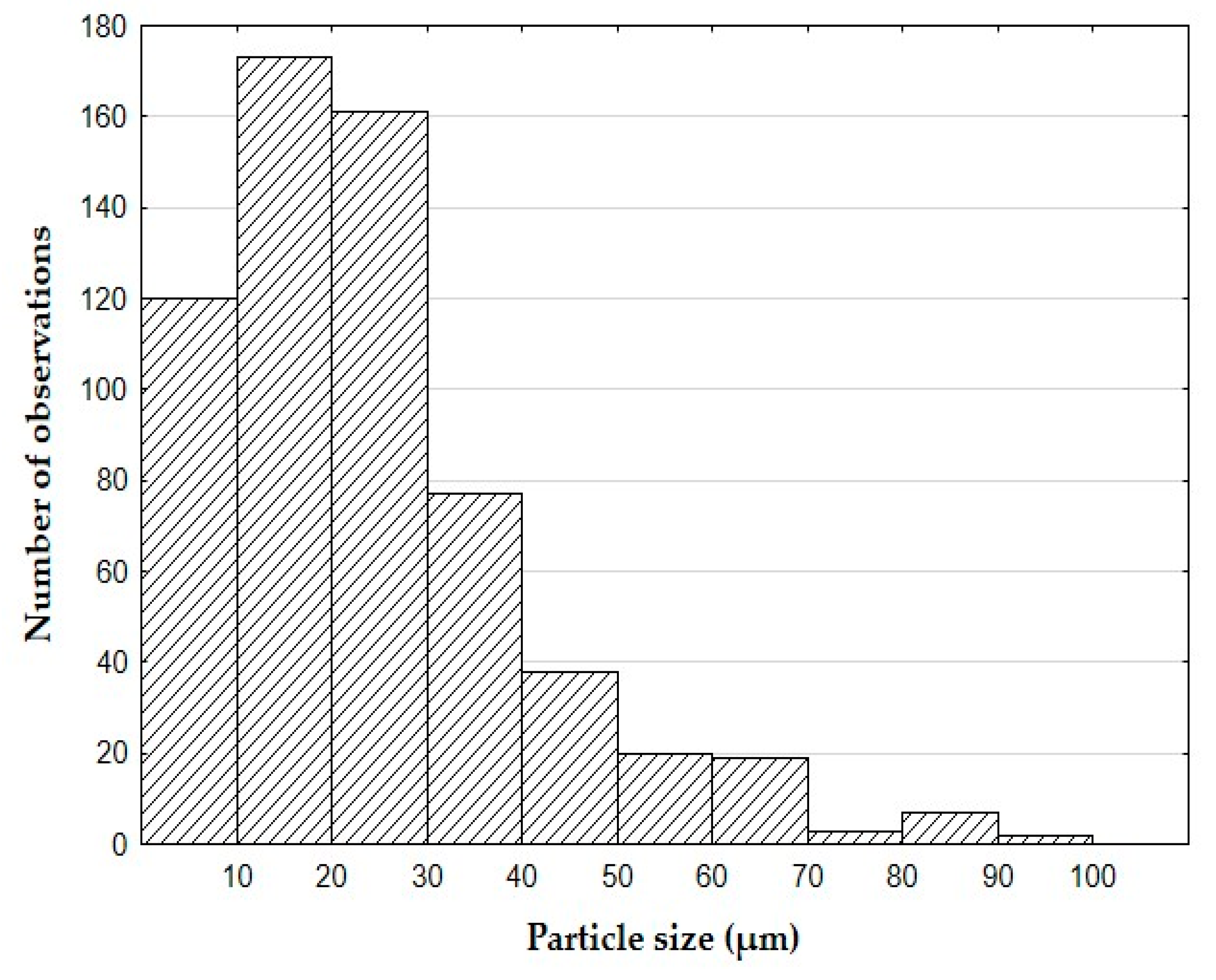


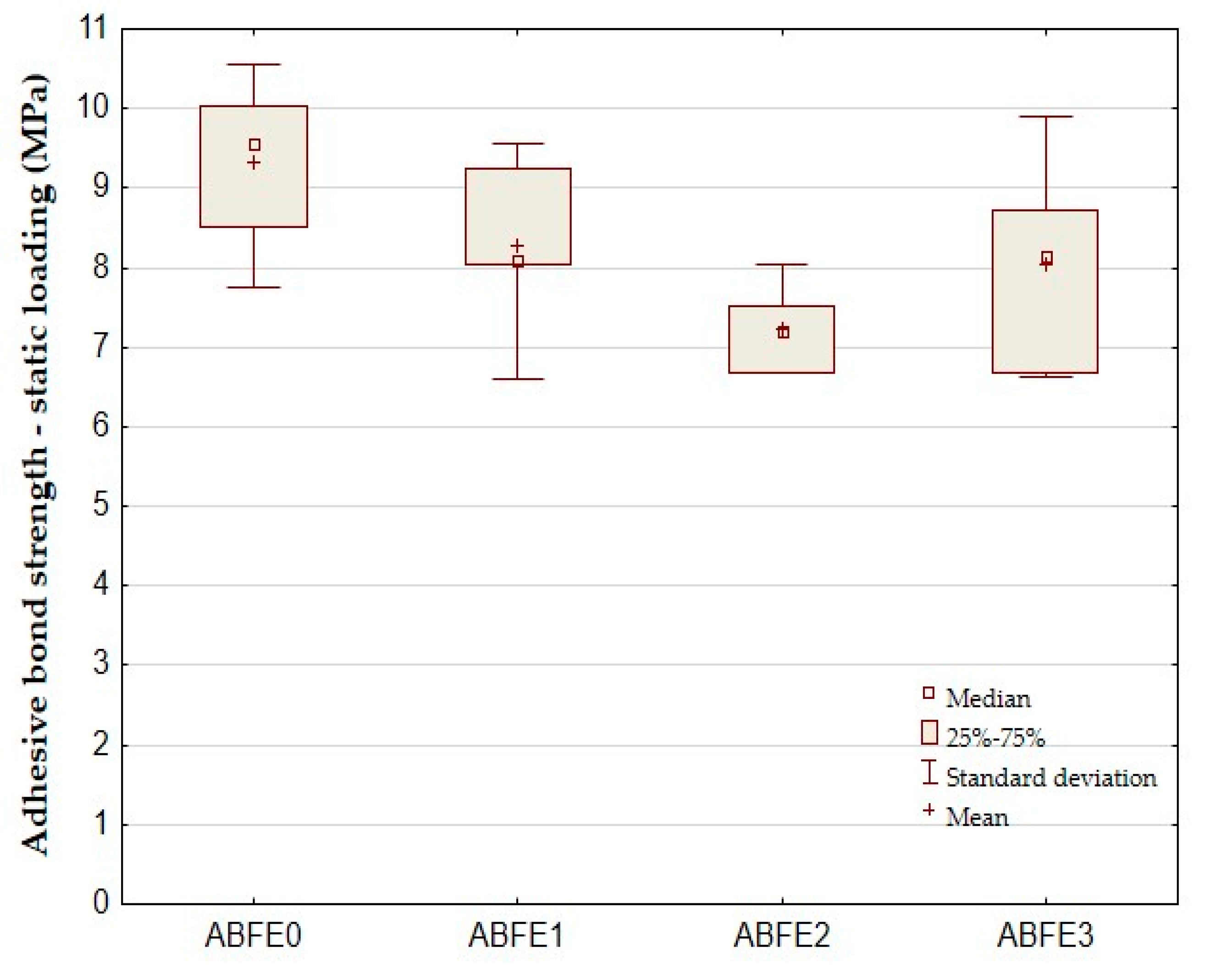
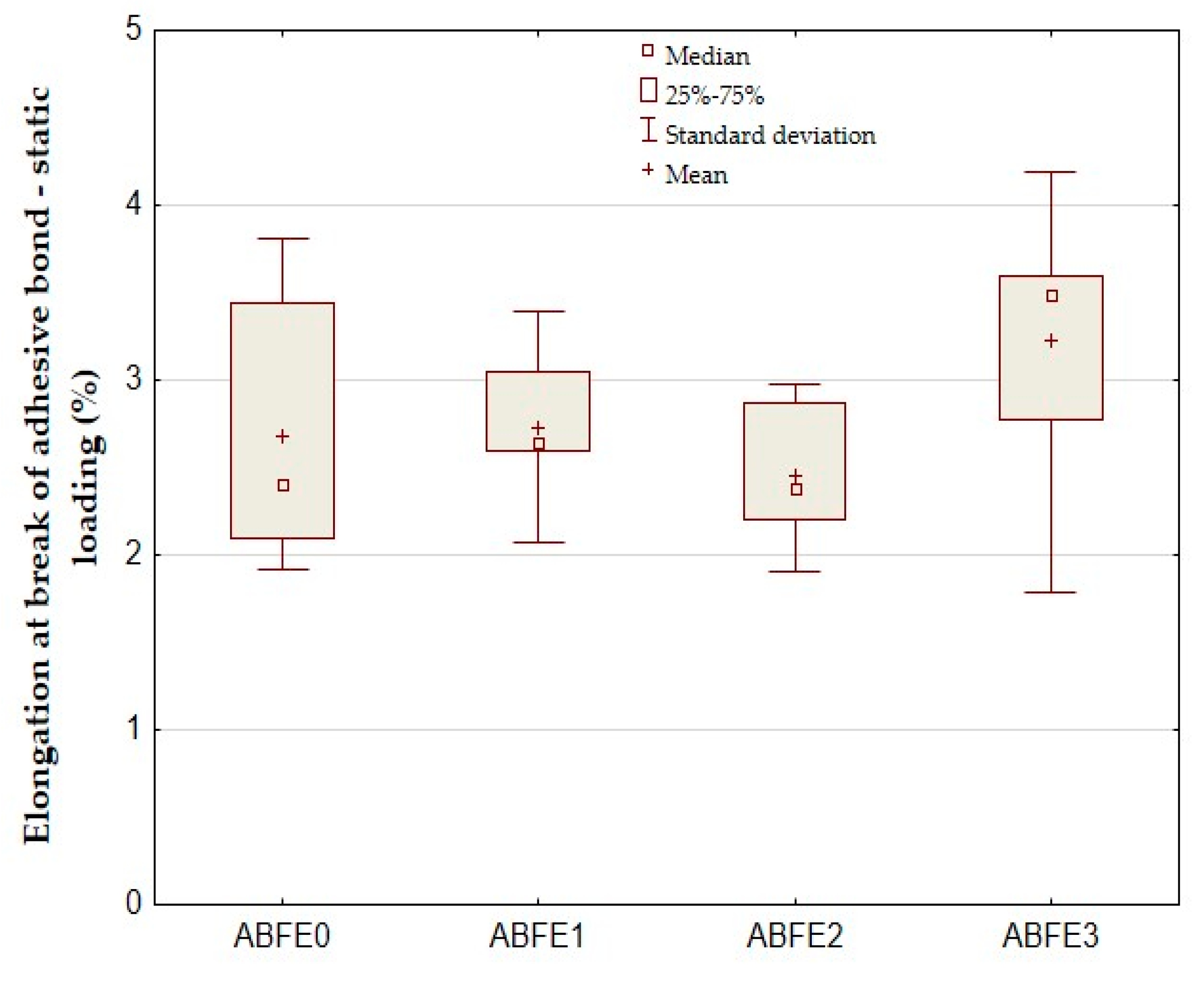
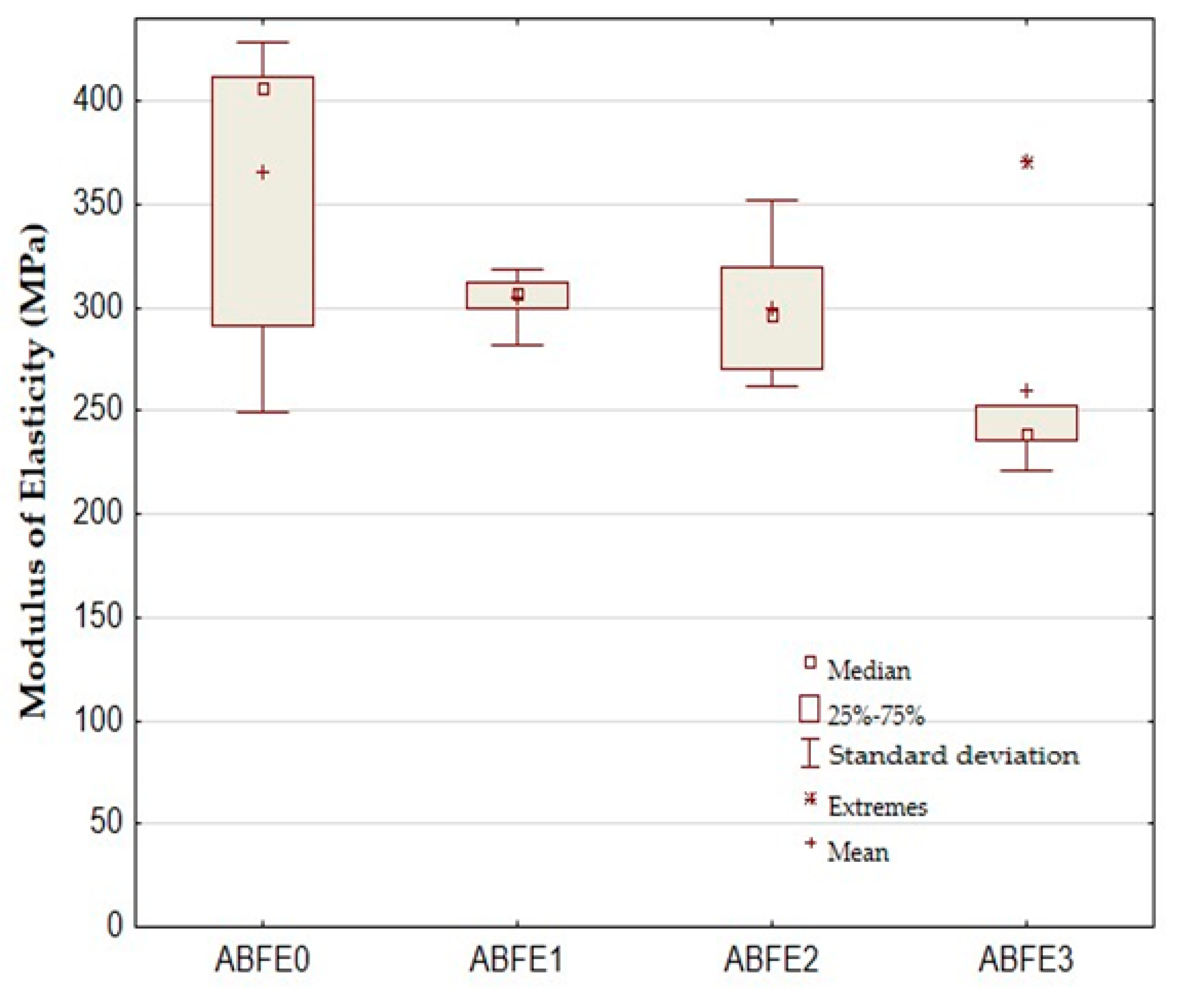
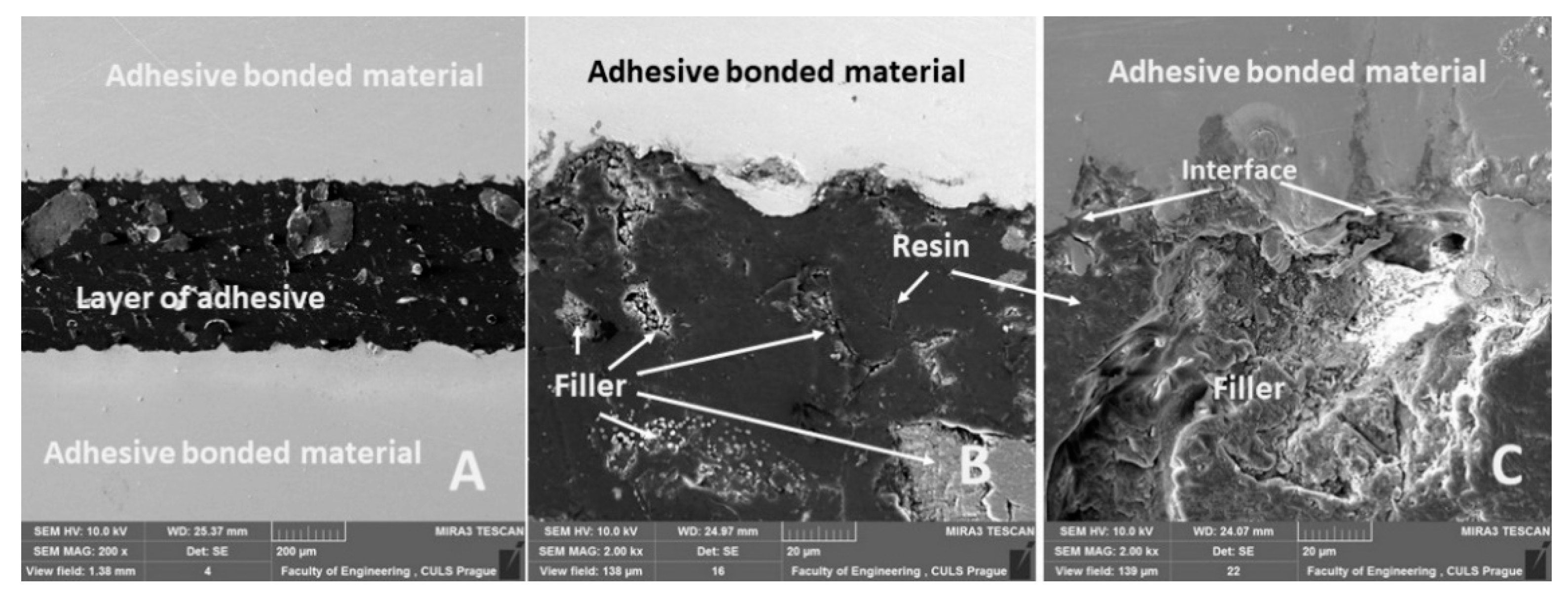
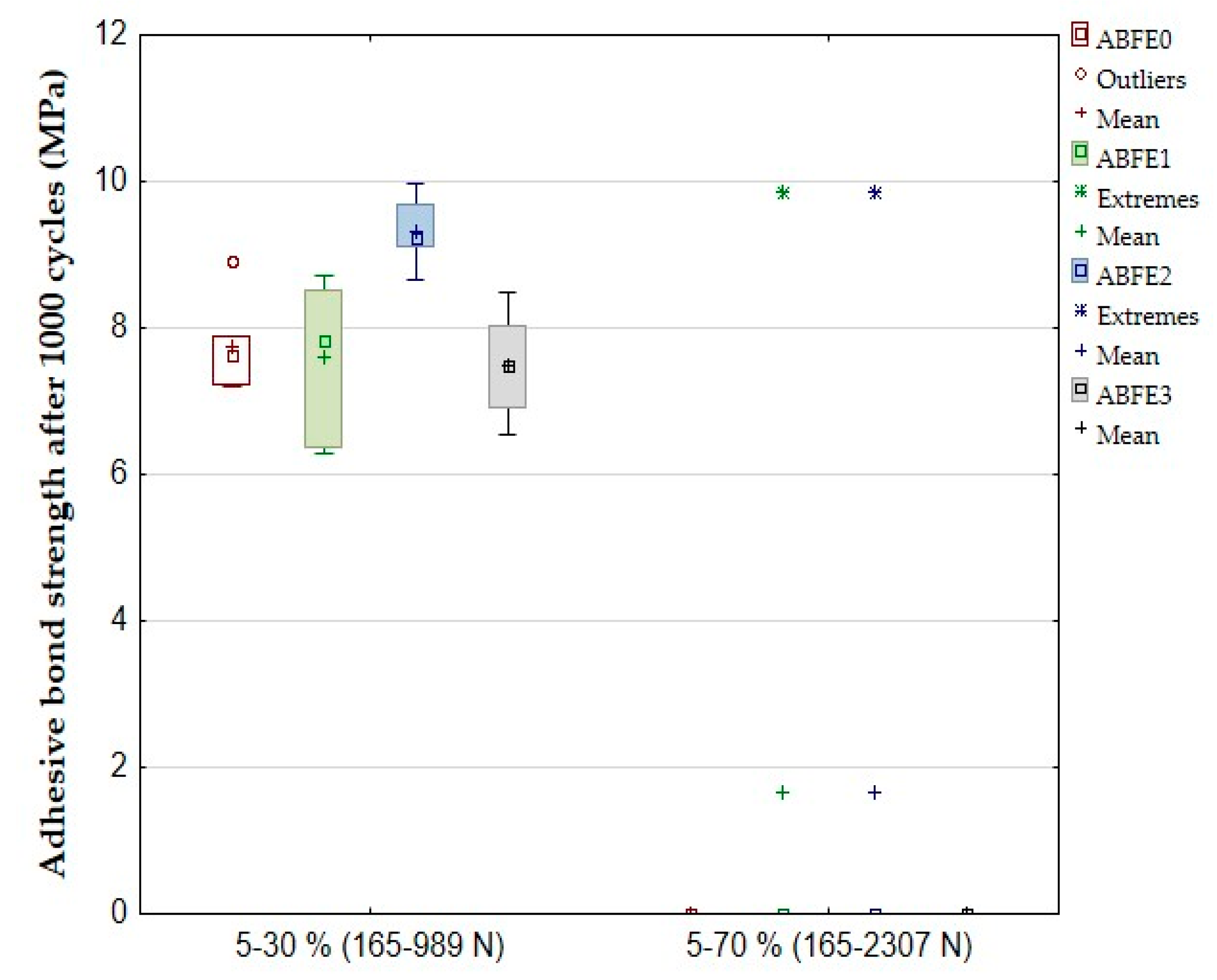
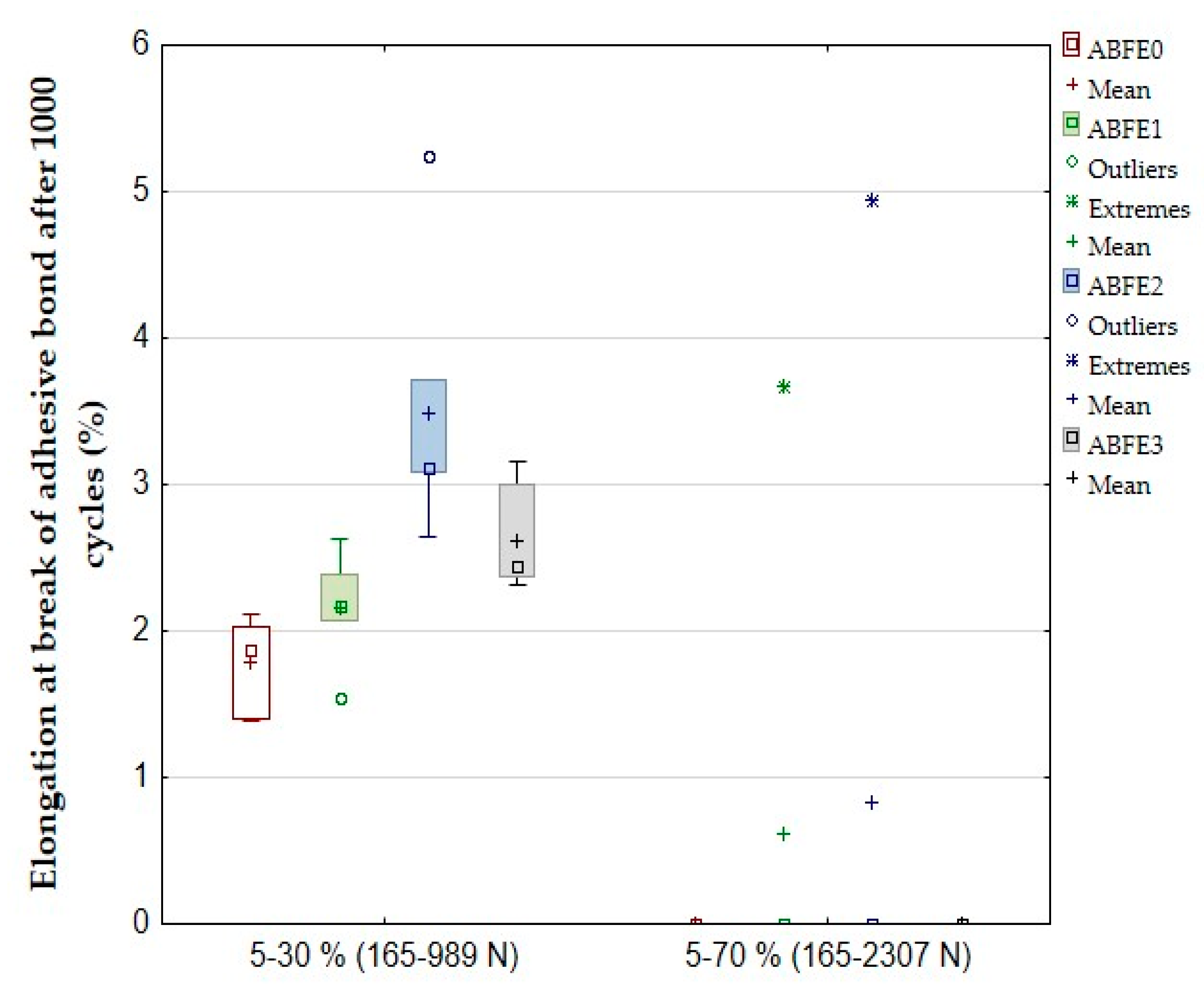
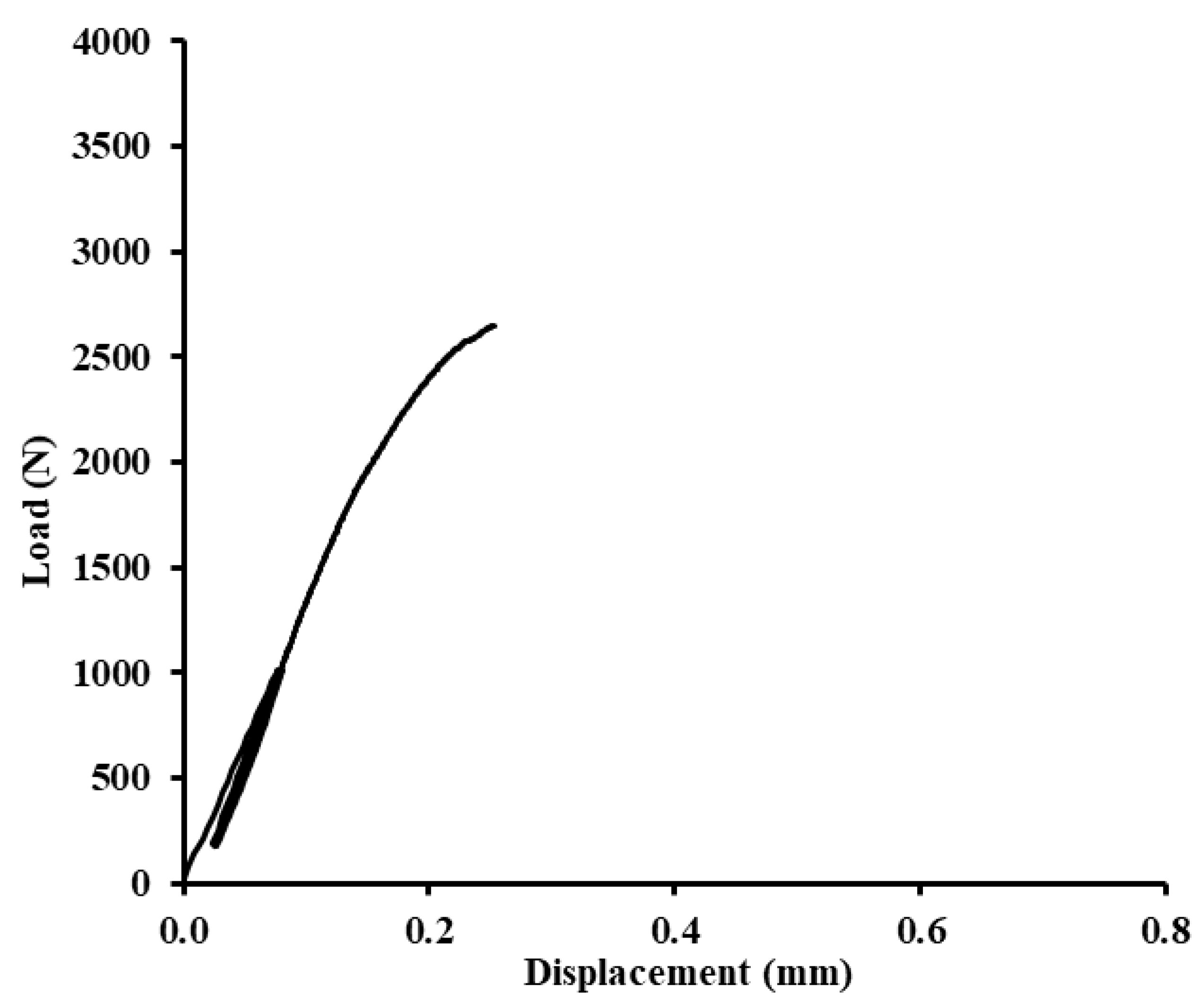
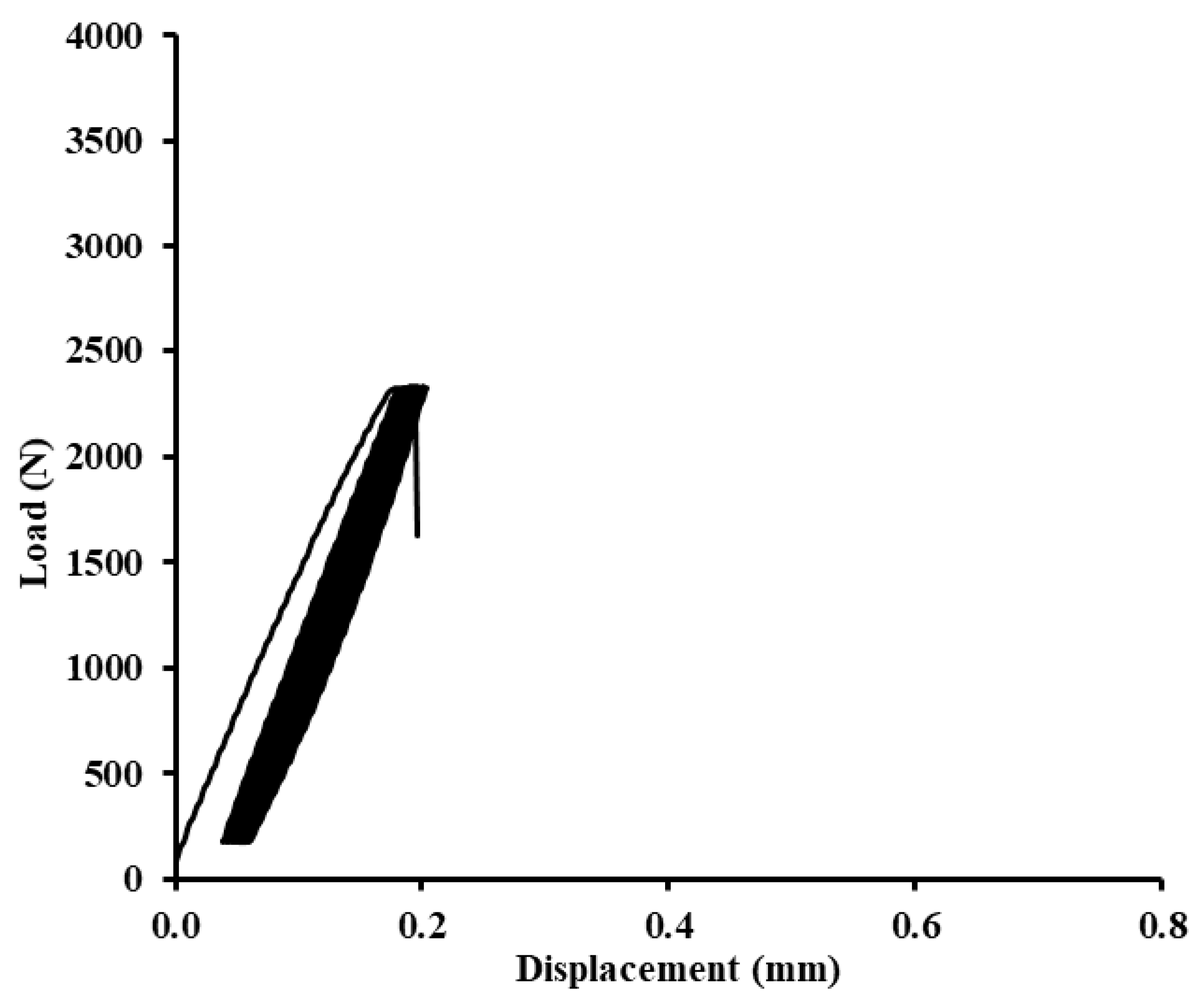
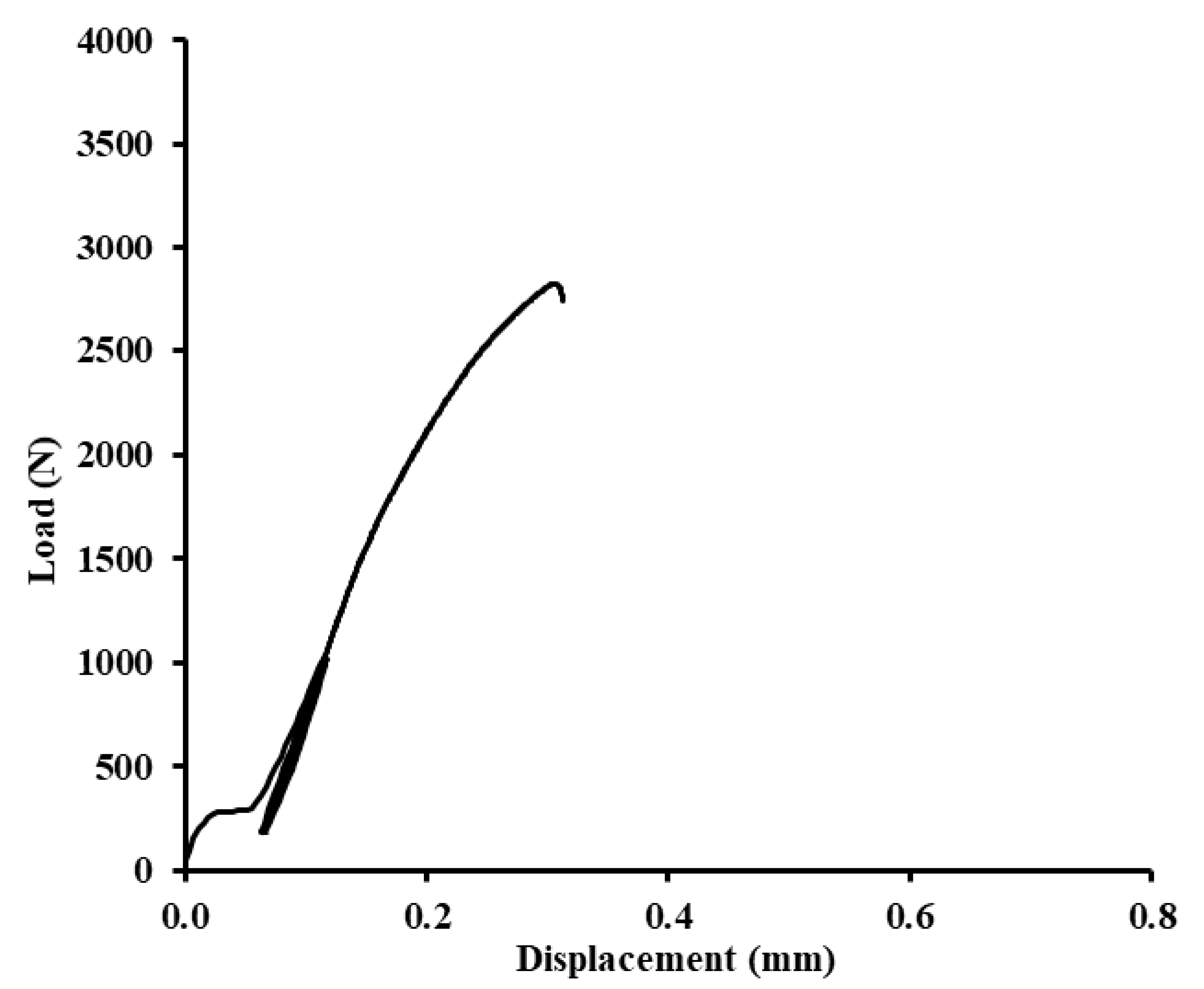
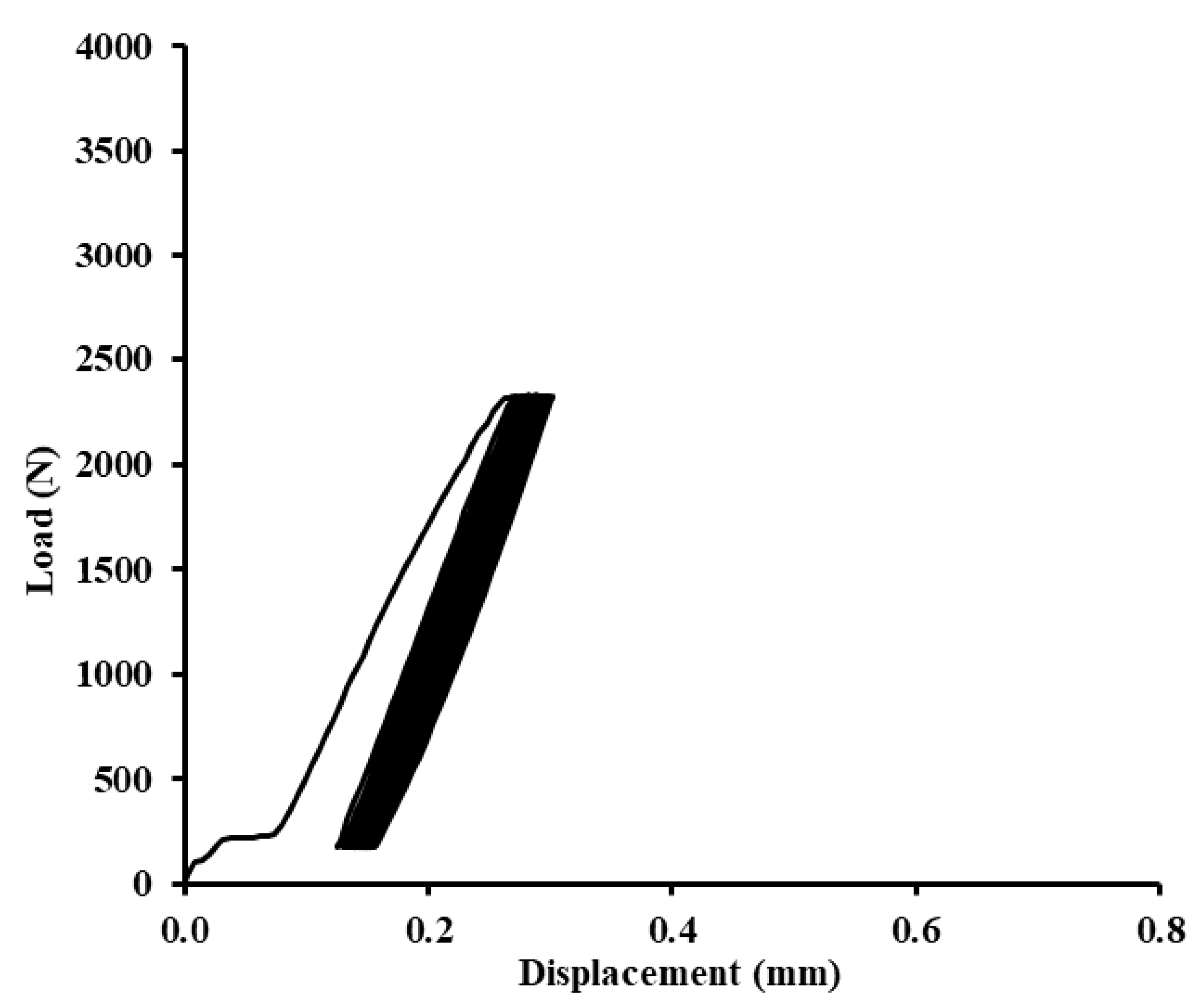
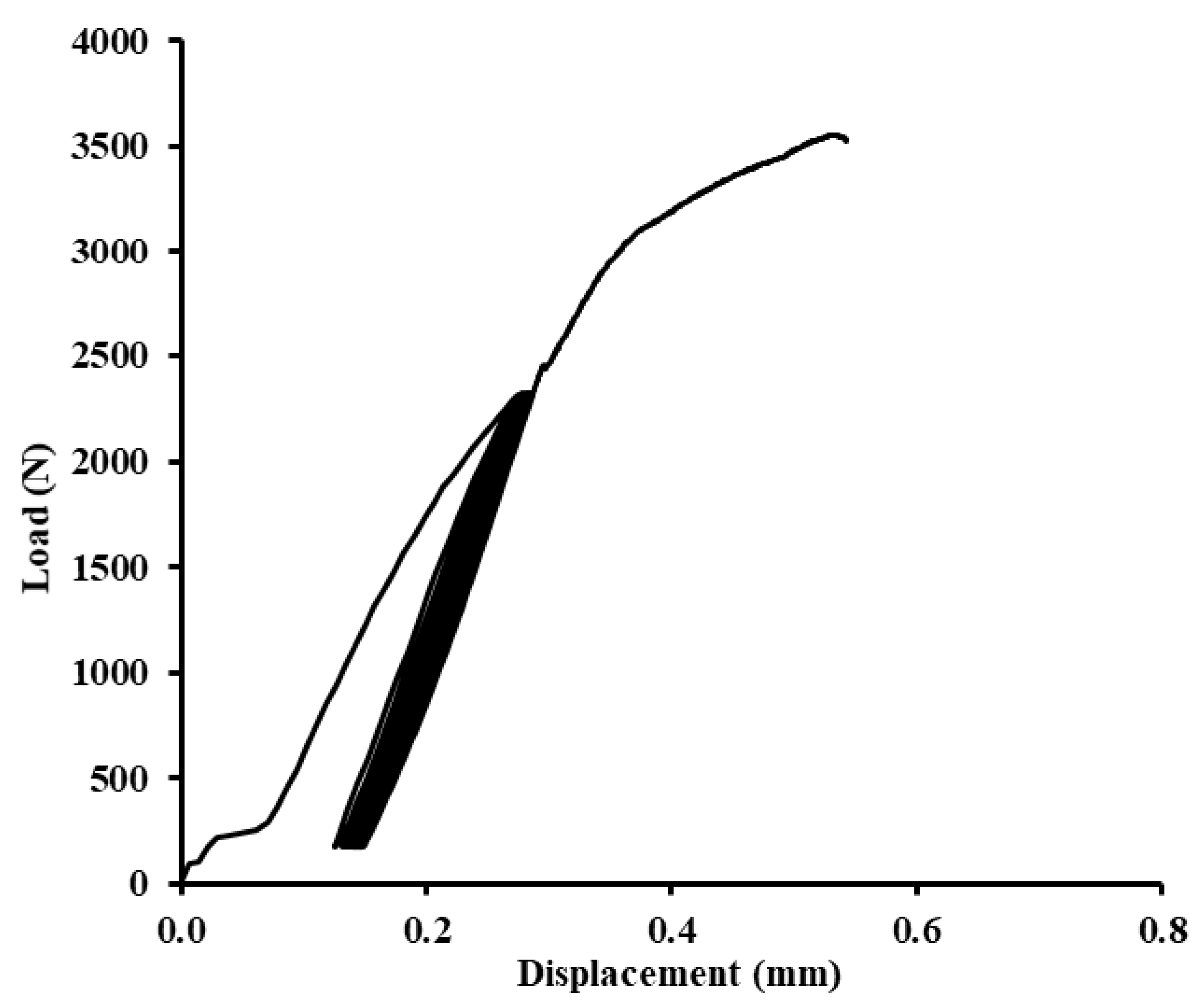

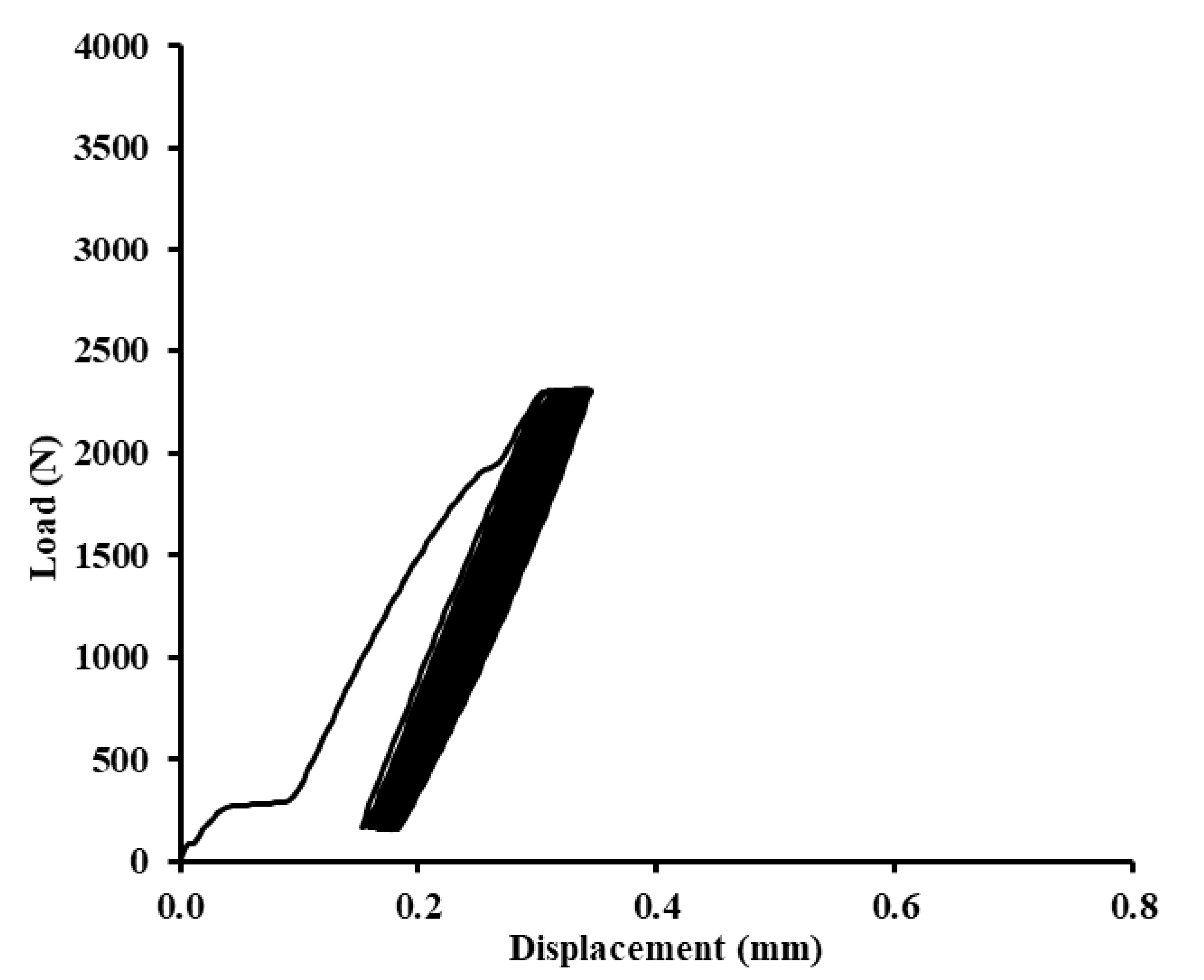
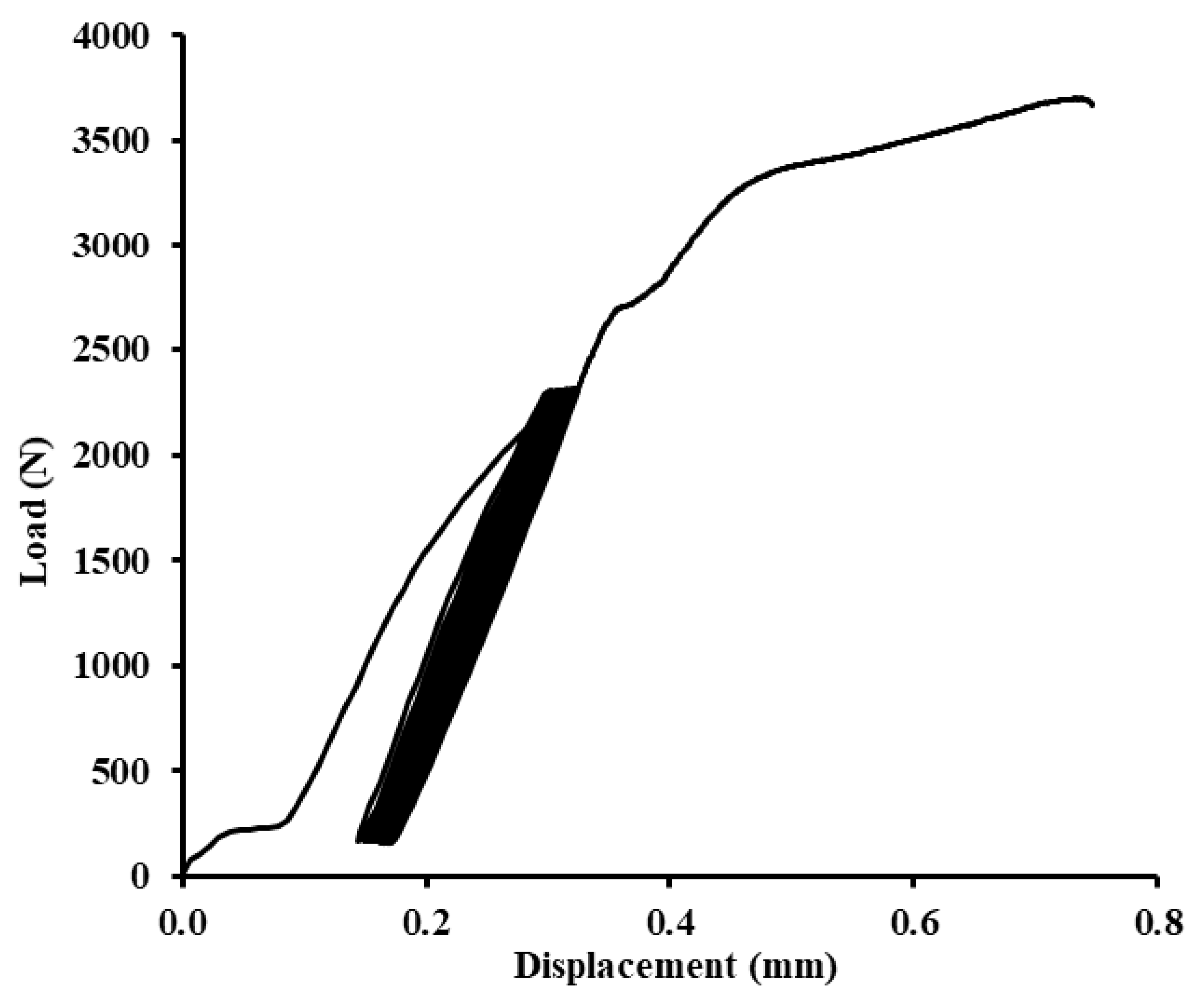

| Arithmetic Mean (µm) | Mode (µm) | Median (µm) |
|---|---|---|
| 28.80 ± 15.48 | 19.60 | 23.265 |
| Sample | Characteristic |
|---|---|
| ABFE0 | Adhesive bond without filler |
| ABFE1 | Adhesive bond with filler (mass ratio 10:1) |
| ABFE2 | Adhesive bond with filler (mass ratio 10:2) |
| ABFE3 | Adhesive bond with filler (mass ratio 10:3) |
| Testing of Adhesive Bonds under Shear Tensile Stress | ABFE0 | ABFE1 | ABFE2 | ABFE3 |
|---|---|---|---|---|
| Adhesive bond strength (MPa) | 0.0000 | 0.1097 | 0.0012 | 0.0820 |
| Elongation at break (%) | 0.0000 | 0.8839 | 0.5401 | 0.2665 |
| Modulus of Elasticity (MPa) | 0.0000 | 0.1086 | 0.0779 | 0.0219 |
| Adhesive Bond | Quasi-Static Test | Number of Finished Tests | Relative Deformation 1st Cycle (%) | Relative Deformation 1000th Cycle (%) |
|---|---|---|---|---|
| ABFE0 | 5%–30% 165 N–989 N | 6/6 | 0.14 ± 0.06 | 0.15 ± 0.06 |
| ABFE1 | 6/6 | 0.48 ± 0.04 | 0.50 ± 0.05 | |
| ABFE2 | 6/6 | 0.60 ± 0.05 | 0.62 ± 0.05 | |
| ABFE3 | 6/6 | 0.77 ± 0.07 | 0.82 ± 0.06 | |
| ABFE0 | 5%–70% 165 N–2307 N | 0/6 | 0.35 ± 0.07 | 0.50 ± 0.09 |
| ABFE1 | 1/6 | 0.87 ± 0.07 | 1.04 ± 0.10 | |
| ABFE2 | 1/6 | 1.04 ± 0.09 | 1.23 ± 0.06 | |
| ABFE3 | 0/6 | 1.16 ± 0.04 | 1.30 ± 0.09 |
| Testing of Adhesive Bonds under Shear Tensile Stress | ABFE0 | ABFE1 | ABFE2 | ABFE3 |
|---|---|---|---|---|
| Adhesive bond strength (MPa) | 0.0000 | 0.0058 | 0.0009 | 0.0000 |
| Elongation at break (%) | 0.0000 | 0.0333 | 0.0148 | 0.0000 |
© 2020 by the authors. Licensee MDPI, Basel, Switzerland. This article is an open access article distributed under the terms and conditions of the Creative Commons Attribution (CC BY) license (http://creativecommons.org/licenses/by/4.0/).
Share and Cite
Kolář, V.; Müller, M.; Mishra, R.; Rudawska, A.; Šleger, V.; Tichý, M.; Hromasová, M.; Valášek, P. Quasi-Static Tests of Hybrid Adhesive Bonds Based on Biological Reinforcement in the Form of Eggshell Microparticles. Polymers 2020, 12, 1391. https://doi.org/10.3390/polym12061391
Kolář V, Müller M, Mishra R, Rudawska A, Šleger V, Tichý M, Hromasová M, Valášek P. Quasi-Static Tests of Hybrid Adhesive Bonds Based on Biological Reinforcement in the Form of Eggshell Microparticles. Polymers. 2020; 12(6):1391. https://doi.org/10.3390/polym12061391
Chicago/Turabian StyleKolář, Viktor, Miroslav Müller, Rajesh Mishra, Anna Rudawska, Vladimír Šleger, Martin Tichý, Monika Hromasová, and Petr Valášek. 2020. "Quasi-Static Tests of Hybrid Adhesive Bonds Based on Biological Reinforcement in the Form of Eggshell Microparticles" Polymers 12, no. 6: 1391. https://doi.org/10.3390/polym12061391
APA StyleKolář, V., Müller, M., Mishra, R., Rudawska, A., Šleger, V., Tichý, M., Hromasová, M., & Valášek, P. (2020). Quasi-Static Tests of Hybrid Adhesive Bonds Based on Biological Reinforcement in the Form of Eggshell Microparticles. Polymers, 12(6), 1391. https://doi.org/10.3390/polym12061391









